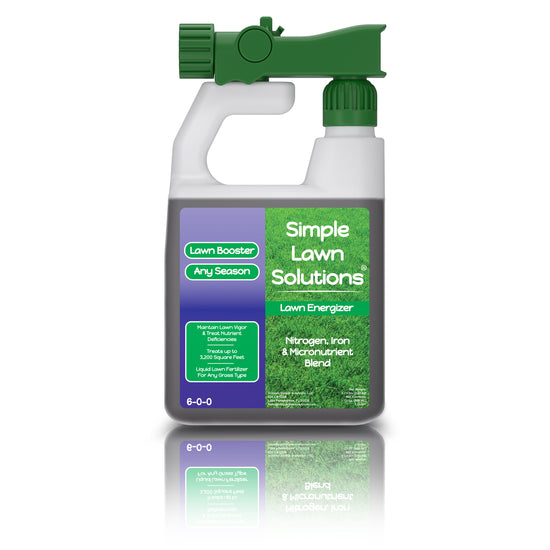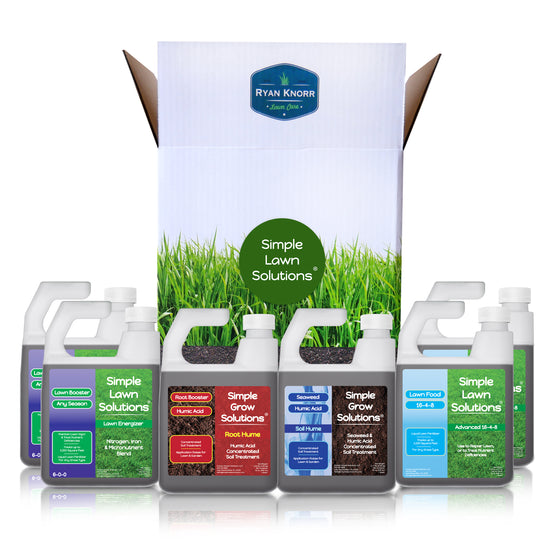
We all strive to have the healthiest, most plush lawn on the block. Curb appeal comes with your grass seed of choice, proper lawn care, and a little bit of TLC. If you find yourself putting in the time without seeing desirable outcomes, it may be time to take a closer look at your knowledge of the lawn you have. If you're contemplating reseeding your yard, you'll want to get to know all your options to make the best lawn care choices for your oasis.
Understanding Grass Seed Options
Grass seeds are not a one size fits all. There is much to consider when setting your sites on creating the block's must-have yard. Soil, sun, shade, and climate are all factors. Look at your neighbors' yards and take note of what catches your eye. What do you consider ultimate curb appeal, and how can you have that, too? From the right nutrients to selecting a grass seed conducive to your environment, we want to help you choose the products that will bring you your dream yard. Let's take a look at various grass seeds, how and where they thrive, and how you can bring that lush look to your yard.
Types of Grass Seed
Selecting the grass seed that fits your yard's needs as well as your vision of curb appeal takes a bit of research. We've done the bulk of it for you to get you on your way to achieving that beautiful, lush look you've been wanting. We'll help you narrow down your search for the grass that will fit your needs by evaluating the pros and cons of seeding.
Kentucky Bluegrass Seed
Are you eyeing a neighbor's thick, lush, boat-shaped blades from across the way? No need for grass envy when you too can have that luscious, dark green Kentucky bluegrass blanketing your yard. Before you get too excited, there are a few things to consider before selecting bluegrass seed. It's a bit picky about where it likes to thrive, so consider your location first. Kentucky bluegrass will grow just about anywhere in the central to the northern US but thrives in bright sun, with a lower tolerance for shady areas than other seed types. Bluegrass seed is one of the longest days to germination, so have patience young grasshopper. If you want a quick lawn, this is not for you. Bluegrass is a homeowner's best friend because it's relatively low maintenance and aesthetically pleasing in a yard.
Kentucky Bluegrass is a solid choice of seed for your yard for many additional reasons: 
- Thick, durable blades
- Dense growth
- Dark Green, Medium-textured turf
- Flourishes within the fertile landscape
Perennial Ryegrass
You'll typically find perennial ryegrass in cool-season climates. It's known for fast germination. Perennial ryegrass has a fine to medium texture, lush blades, and great disease tolerance. It will even return year to year with the right climate and TLC.
Ryegrass isn't very drought tolerant and flourishes with substantial amounts of water. Upon seeding, it establishes itself rather quickly. Because of this, you'll notice it takes on a longer growing season than typical grasses. Plant your ryegrass seed in rich, dark, fertile soil, then sit back and reap the rewards.
Fescues
Fescue offers a resilient and durable lawn solution. Fescue is the seed of choice if you're dealing with high heat, drought, and shady areas. It is more disease resistant than some grasses, but it's also more challenging to repair sections of fescue that suffer damage.

Fescue establishes itself from seed and grows in a bunch or short variety. Homeowners love this option since it stays green year-round and keeps curb appeal constant with proper lawn care.
Tall fescue, with its course, and lush blades, is typically standard for residential use. Tall fescue has a deep root system and, therefore, significant water storage capabilities. The root system helps it endure drought, so it is an excellent choice for dryer climates.
Fine fescue thrives in colder climates and areas with an abundance of shade. It commands minimal lawn care and has a low watering and liquid fertilizer requirement. Fine fescue comes in five notable species: hard fescue, sheep fescue, chewings fescue, creeping red fescue, and slender creeping red fescue. Creeping red fescue is ideal for golf courses and residential use, as it can "creep" into areas, fill in, and flourish. Since it can seek out and fill in sparse areas naturally, lawn care is minimal.
Using a seed blend of all five fescues creates extra durability and resilience in your yard and withstands more difficult soil conditions, including rock, sand, and clay. However, it doesn't hold up well in higher-traffic areas. Keep this in mind if you have kiddos and pets or enjoy cookouts in the backyard.
Bahiagrass Seed
Bahiagrass is a warm-season, tropical grass that will thrive despite extensive droughts and heat. It is a durable, low-growing option that also requires minimal lawn care and maintenance. Bahia is coarse in texture with an extensive root system for sustainable hydration. The full sun is also ideal for this grass, making the Gulf Coast a preferable location for growing.
Bermudagrass Seed
Bermuda is undoubtedly the most popular turf grass for most of the world's tropical and temperate parts. It's a lush option and is resistant to the damaging heat of summer. This warm-season grass will brown in cold weather, flourish in extensive heat, and can revive itself quickly with little lawn care needed aside from that which mother nature provides. Henceforth, it is the perfect choice for golf courses and sporting fields.

Common bermuda is ideal for various lawn care demands, including erosion control, and adapts nicely to various soil types. While Bermuda grass works best in well-drained areas, it also survives well during small bouts of flooding. Common bermudagrass is the most cost-effective grass seed, so if you require a budget-friendly lawn option, this may be your answer.
Although these are excellent pros for your grass, it's worth noting the downside of bermuda. Some consider this grass nothing more than a weed, killing crops and stubbornly sprouting up again after eradicating it. Its seeds are minuscule, allowing easy deposits from your lawnmower, animals, and people as they cross your yard or field. It's a tough grass to rid yourself of, so think long and hard about your wants and needs before choosing Bermuda. It also will not tolerate shade, so if you have a lot of trees, try a different grass.
Zoysiagrass Seed
Zoysiagrass is among the top five warm-season grass choices, and for a good reason. Zoysiagrass may or may not be an ideal fit for your yard needs, depending on three crucial factors:

- Your climate
- Your lawn care goals
- The amount of foot traffic your yard will receive
Zoysia is a warm-season grass with cold tolerance abilities. Lawn care maintenance includes low watering needs, ideal for most homeowners, and this grass is suitable for Southern and transitional climates. Zoysiagrass prefers to be in the sun but will tolerate shade if necessary. Most yard enthusiasts appreciate its heat and drought resistance, and dense growth suitable for high traffic.
Proper Lawn Care
Now that you have plenty of grass seed options to consider let's talk lawn care. While there are many different liquid fertilizer lawn care products, there are a few we always recommend for a healthy, lush yard you'll be proud to show off.
Knowing your lawn is essential to providing proper lawn care. With each different grass seed comes different requirements to help it flourish and maintain its optimal growth.
There are three main categories of lawn care products:
- Lawn food
- Lawn boosters
- Soil treatments
Each of these lawn care products supports your grass seed differently. Some compensate for soil deficiencies while others support it through drought or dead areas. Let's get to know the ins and outs of liquid fertilizer and why it is an essential part of proper lawn care.
Liquid Fertilizer
Specialty fertilizers focus on grass seed growth, the strength of your lawn, and its root development. With proper liquid fertilizer, grass seed care, and lawn upkeep techniques, your grass will thrive in no time. The use of liquid fertilizer makes a world of difference and offers conveniences such as:
- Easy-to-use application, with no spreading equipment necessary
- Pre-mixed nutrients for even application
- Quick, undeniable results
Liquid fertilizers offer a well-balanced blend of three essential macronutrients- nitrogen, phosphorus, and potassium. These three nutrients are critical for grass seed health and growth. With the use of a homogeneous liquid fertilizer mixture, you'll distribute equal amounts of nutrients for your grass seed and flourishing lawn during each application. Liquid fertilizer penetrates deep into the ground, promoting the health of both your grass seeds, grass growth, and soil. It's merely a win-win no matter how you look at it.
Liquid fertilizer is entirely safe for all grass types and safe for your kids and pets to play on after application. Making liquid fertilizer a part of your grass seed and lawn upkeep routine will bring results you can boast.
When to Apply Liquid Fertilizer
Knowing your grass and soil will help you determine when liquid fertilizer is optimal for your yard. You'll need to consider a couple of factors, including grass seed type and your climate.
Fertilization typically takes place two times a year: in fall and spring. The absolute minimum you should fertilize is once a year, but there are several reasons your lawn may benefit from increasing fertilization:

- Choking out stubborn weeds
- Thickening thinning grass
- Enhancing the green of your lawn
- Improving seed germination
It will be essential to monitor how your lawn responds to your lawn care routine and adjust your approach accordingly. Your grass seed and the ongoing health of your lawn will thank you by thriving.
When is Fertilizing Optimal?

You need to understand optimal fertilization periods regardless of seed type. Warm-season grass does best with June and August application, with occasional reapplication in September. Cool-season grass fertilization provides optimal benefits when applied in May and September, or approximately six weeks before your region's first frost.
These are generally best practice guidelines for proper lawn care. Knowing your specific grass seed type and needs will bring you ultimate results.
It's time to get out there and create the yard all of your neighbors will envy!













2 comments
Hello Mike,
We recommend fertilizing on a different day than mowing! If you have any additional questions please reach out to us by emailing us at hello@simplelawnsolutions.com
Is it better to have grass cut first before I applied lawn solution or not